Space station
2008/9 Schools Wikipedia Selection. Related subjects: Space transport
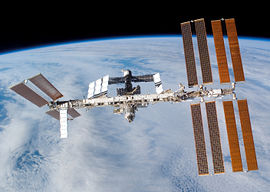
A space station is an artificial structure designed for humans to live in outer space. So far only low earth orbit (LEO) stations are implemented, also known as orbital stations. A space station is distinguished from other manned spacecraft by its lack of major propulsion or landing facilities — instead, other vehicles are used as transport to and from the station. Space stations are designed for medium-term living in orbit, for periods of weeks, months, or even years. The only space station currently in use is the International Space Station. Previous ones are the Almaz, Salyut series, Skylab and Mir
Space stations are currently (as of 2007) used to study the effects of long-term space flight on the human body as well as to provide platforms for greater number and length of scientific studies than available on other space vehicles. Since the ill-fated flight of Soyuz 11 to Salyut 1, all manned spaceflight duration records have been set aboard space stations. The duration record of 437.7 days was set by Valeriy Polyakov aboard Mir from 1994 to 1995. As of 2008, three astronauts have completed single missions of over a year, all aboard Mir.
Uses
Space stations have been used for both military and civilian purposes. The last military-use space station was Salyut 5, which was used by the Almaz program of the Soviet Union in 1976 and 1977.
Types of space stations
Monolithic
Broadly speaking, the space stations so far launched have been of two types; the earlier stations, Salyut and Skylab, have been "monolithic", intended to be constructed and launched in one piece, and then manned by a crew later. As such, they generally contained all their supplies and experimental equipment when launched, and were considered "expended", and then abandoned, when these were used up.
Starting with Salyut 6 and Salyut 7, a change was seen; these were built with two docking ports, which allowed a second crew to visit, bringing a new spacecraft with them (for technical reasons, a Soyuz capsule cannot safely spend more than a few months in orbit, even powered down). This allowed for a crew to man the station continually. Skylab was also equipped with two docking ports, like second-generation stations, but the extra port was never utilized. The presence of a second port on the new stations allowed Progress supply vehicles to be docked to the station, meaning that fresh supplies could be brought to aid long-duration missions. This concept was expanded on Salyut 7, which "hard docked" with a TKS tug shortly before it was abandoned; this served as a proof-of-concept for the use of modular space stations. The later Salyuts may reasonably be seen as a transition between the two groups.
Modular
The second group, Mir and the ISS, have been modular; a core unit was launched, and additional modules, generally with a specific role, were later added to that. (On Mir they were usually launched independently, whereas on the ISS most are brought by the Shuttle). This method allows for greater flexibility in operation, as well as removing the need for a single immensely powerful launch vehicle. These stations are also designed from the outset to have their supplies provided by logistical support, which allows for a longer lifetime at the cost of requiring regular support launches.
Habitability issues
These stations have various issues that limit their long-term habitability, such as very low recycling rates, relatively high radiation levels and a lack of gravity. Some of these problems cause discomfort and long-term health effects. In the case of solar flares, all current habitats are protected by the Earth's magnetic field, and are below the Van Allen belts.
Future space habitats may attempt to address these issues, and are intended for long-term occupation. Some designs might even accommodate large numbers of people, essentially "cities in space" where people would make their homes. No such design has yet been constructed, because even for a small station, the extra equipment is too expensive to place in orbit at current (2008) launch costs.
Possible ways to deal with these costs would be building lots of rockets (economies of scale), reusable rockets, In Situ Resource Utilisation or if space elevators are ever able to be constructed.
Architecture
A space station is a complex system with many subsystems. These subsystems are interrelated in a medium or large sense; thus, each subsystem is designed considering the others. All of these subsystems should be safe and function reliably.
The main subsystems of a space station are:
- Structure
- Electric energy
- Termical control
- Navigation and orientation control
- Propulsion
- Automation and robotics
- Informatics and communications
- Environmental control and fluids distribution
- Lodging and other services for crew
- Crew and loads transport
Past and present space stations
(dates refer to periods when stations were inhabited by crews)
- Salyut space stations (USSR, 1971-1986)
- Salyut 1 (1971, 1 crew and 1 failed docking)
- DOS-2 (1972, launch failure)
- Salyut 2/ Almaz (1973, failed shortly after launch)
- Cosmos 557 (1973, re-entered eleven days after launch)
- Salyut 3/Almaz (1974, 1 crew and 1 failed docking)
- Salyut 4 (1975, 2 crews)
- Salyut 5/Almaz (1976-1977, 2 crews and 1 failed docking)
- Salyut 6 (1977-1981, 16 crews (5 long duration, 11 short duration and 1 failed docking)
- Salyut 7 (1982-1986, 10 crews (6 long duration, 4 short duration and 1 failed docking)
- Skylab space station (USA, 1973-1974, 3 crews)
- Mir space station (USSR/Russia, 1986-2000, 28 long duration crews)
- International Space Station (ISS) (USA, Russia, Japan, European Space Agency, Canada, Brazil, Italy 2000-ongoing, 17 long duration crews to date)
Following the controlled deorbiting of Mir in 2001, the International Space Station is the only one of these currently in orbit; it has been continuously occupied since October 30, 2000. As of 9 September 2006, it was 44.5 metres (146 ft) in length along the core between the Destiny and Zvezda modules or 52 metres (171 ft) long when a Progress is attached, and has a mass of 183.3 metric tons (202.1 short tons).
List of occupied space stations, with statistics
| Space station | Image | Launched | Reentered | Days in use | Total crew and visitors |
Visits | Mass (kg) |
||
|---|---|---|---|---|---|---|---|---|---|
| In orbit | Occupied | Manned | Unmanned | ||||||
| Salyut 1 | 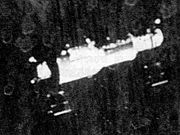 |
Apr 19, 1971 01:40:00 UTC |
Oct 11, 1971 | 175 | 24 | 3 | 2 | 0 | 18,425 kg (40,620 lb) |
| Skylab | 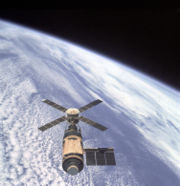 |
May 14, 1973 17:30:00 UTC |
Jul 11, 1979 16:37:00 UTC |
2,249 | 171 | 9 | 3 | 0 | 77,088 kg (169,950 lb) |
| Salyut 3 |  |
Jun 25, 1974 22:38:00 UTC |
Jan 24, 1975 | 213 | 15 | 2 | 1 | 0 | 18,500 kg (40,786 lb) |
| Salyut 4 | 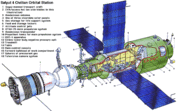 |
Dec 26, 1974 04:15:00 UTC |
Feb 3, 1977 | 770 | 92 | 4 | 2 | 1 | 18,500 kg (40,786 lb) |
| Salyut 5 | 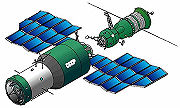 |
Jun 22, 1976 18:04:00 UTC |
Aug 8, 1977 | 412 | 67 | 4 | 2 | 0 | 19,000 kg (41,888 lb) |
| Salyut 6 | 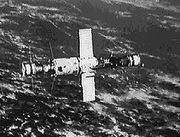 |
Sep 29, 1977 06:50:00 UTC |
Jul 29, 1982 | 1,764 | 683 | 33 | 16 | 14 | 19,000 kg (41,888 lb) |
| Salyut 7 |  |
Apr 19, 1982 19:45:00 UTC |
Feb 7, 1991 | 3,216 | 816 | 26 | 12 | 15 | 19,000 kg (41,888 lb) |
| Mir | 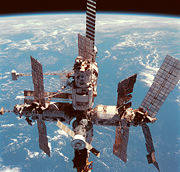 |
Feb 19, 1986 21:28:23 UTC |
Mar 23, 2001 05:50:00 UTC |
5,511 | 4,594 | 137 | 39 | 68 | 124,340 kg (274,123 lb) |
| ISS | 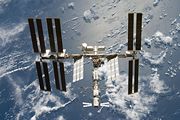 |
Nov 20, 1998 | Currently in orbit Projected 2016 |
†3,429 | †2,753 | †158 | †41 | †32 | †286,876 kg (632,453 lb) |
Crew and visitors counting is non-distinct.
- †ISS stats as of April 10, 2008.
- †ISS stats as of April 10, 2008.25 shuttles, 16 Soyuz, 28 Progress, 1 ATV, 3 automated modules
Canceled space stations
- A second Skylab unit ( Skylab B) was manufactured, as a backup article; due to the high costs of providing launch vehicles, and a desire by NASA to cease Saturn and Apollo operations in time to prepare for the Space Shuttle coming into service, it was never flown. The hull can now be seen in the National Air and Space Museum, in Washington DC, where it is a popular tourist attraction.
- A number of additional Salyuts were produced, as backups or as flight articles that were later canceled.
- The U.S. Space Station Freedom program, which - despite being under development for ten years - was never launched, evolved into the International Space Station
- The Soviet/Russian Mir-2 station, which was never constructed, had some of its elements incorporated into the International Space Station.
- The Industrial Space Facility was a station proposed in the 1980s that was to be privately funded. The project was canceled when the company created to build it, Space Industries Incorporated, was unable to secure funding from the United States government.
- United States Air Force Manned Orbiting Laboratory project, canceled in 1969 about a year before the first planned test flight; this was unusual in being an explicitly military project, as opposed to the Soviet Almaz program, which was heavily intertwined with - and concealed by - the contemporaneous Salyut program.
- The European Columbus project planned to create a small space station serviced by the Hermes shuttle. It evolved into the ISS Columbus module.
Future developments
- Currently, Bigelow Aerospace is developing commercial inflatable habitat modules, derived from the earlier NASA Transhab concept, intended to be used for space station construction and for a space prize they are funding and operating, America's Space Prize. Genesis I and Genesis II are ⅓-scale unmanned prototype modules orbited to test the feasibility of inflatable structures and other systems in space. Future modules include the Galaxy, Sundancer and BA 330, each being progressively larger and more complicated, with the BA 330 intended as the full-scale manned production model for Bigelow's expandable space habitation module program.
- Project 921-2 is the working name given by the People's Republic of China for plans to create a manned space station by 2012.
- In April 2008, the Russian space agency has proposed the construction of an orbital construction yard for spacecraft too heavy to launch from Earth directly. It would not begin construction or be finished until after the decommission of the International Space Station.

